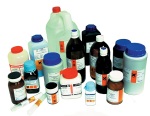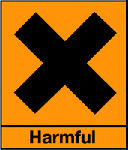Goodness me, you need to read this WotD (Word of the Day) – this ingredient is listed in Johnson’s Baby aqueous lotion…
Sodium hydroxide (NaOH), also known as lye and caustic soda, is a caustic metallic base. It is used in many industries, mostly as a strong chemical base in the manufacture of pulp and paper, textiles, drinking water, soaps and detergents and as a drain cleaner. Worldwide production in 1998 was around 45 million tonnes. Sodium hydroxide is a common base in chemical laboratories.
Pure sodium hydroxide is a white solid; available in pellets, flakes, granules and as a 50% saturated solution. It is hygroscopic and readily absorbs water from the air, so it should be stored in an airtight container. It is very soluble in water with liberation of heat. It also dissolves in ethanol and methanol, though it exhibits lower solubility in these solvents than does potassium hydroxide.
Molten sodium hydroxide is also a strong base, but the high temperature required limits applications. It is insoluble in ether and other non-polar solvents. A sodium hydroxide solution will leave a yellow stain on fabric and paper.
Uses:
Soap production 
Sodium hydroxide is traditionally used in soap making (cold process soap, saponification).It was made in the nineteenth century for a hard surface rather than liquid product because it was easier to store and transship.
Cleaning agent
Sodium hydroxide is frequently used as an industrial cleaning agent where it is often called “caustic”. It is added to water, heated, and then used to clean the process equipment, storage tanks, etc. It can dissolve grease, oils, fats and protein based deposits. The sodium hydroxide solution can also be added surfactants to stabilize dissolved substances to prevent redeposition. A sodium hydroxide soak solution is used as a powerful degreaser on stainless and glass bakeware. It is also a common ingredient in oven cleaners.
A common use of Sodium Hydroxide is in the production of Parts washer detergents. Parts washer detergents based on Sodium Hydroxide are some of the most aggressive parts washer cleaning chemicals. The Sodium Hydroxide based detergent include surfactants, rust inhibitors and defoamers.
A parts washer heats water and the detergent in a closed cabinet and then sprays the heated sodium hydroxide and hot water at pressure against dirty parts for degreasing applications.
Sodium Hydroxide used in this manner replaced many solvent based systems in the early 1990s when triclor was outlawed. Water and Sodium Hydroxide detergent based parts washers are considered to be an environmental improvement over the solvent based cleaning methods.
This is a process that was used with farm animals at one time. This process involves the placing of a carcass into a sealed chamber, which then puts the carcass in a mixture of sodium hydroxide and water, which breaks chemical bonds keeping the body intact.
This eventually turns the body into a coffee-like liquid, and the only solid that remains are bone hulls, which could be crushed between one’s fingertips. Sodium hydroxide is frequently used in the process of decomposing roadkill dumped in landfills by animal disposal contractors.
Sodium hydroxide has also been used by criminals to dispose of their victims’ bodies.
Food uses of sodium hydroxide include washing or chemical peeling of fruits and vegetables, chocolate and cocoa processing, caramel coloring production, poultry scalding, soft drink processing, and thickening ice cream. Olives are often soaked in sodium hydroxide to soften them, while pretzels and German lye rolls are glazed with a sodium hydroxide solution before baking to make them crisp. Due to the difficulty in obtaining food grade sodium hydroxide in small quantities for home use, Sodium carbonate is often used in place of sodium hydroxide.
Domestic uses 
Sodium hydroxide is used in the home as a drain cleaning agent for clearing clogged drains. It is distributed as a dry crystal or as a thick liquid gel. The chemical mechanism employed is the conversion of grease to a form of soap.
Soap is water-soluble, and can be dissolved by flushing with water. This conversion occurs far more rapidly at high temperatures, so commercial drain cleaners may also contain chemicals that react with water to generate heat. Sodium hydroxide also decomposes complex molecules such as the protein that composes hair.
Such drain cleaners (and their acidic versions) are highly caustic and should be handled with care.
Sodium hydroxide has been used as a relaxer to straighten hair. However, because of the high incidence and intensity of chemical burns, chemical relaxer manufacturers have now switched to other alkaline chemicals. Sodium hydroxide relaxers are still available, but they are used mostly by professionals.
Solid sodium hydroxide or solutions of sodium hydroxide will cause chemical burns, permanent injury or scarring if it contacts unprotected human or animal tissue. It will cause blindness if it contacts with the eye. Protective equipment such as rubber gloves, safety clothing and eye protection should always be used when handling the material or its solutions. 
Dissolution of sodium hydroxide is highly exothermic, and the resulting heat may cause heat burns or ignite flammables. It also produces heat when reacted with acids. It is corrosive to glass and some metals. Keep away from aluminum.
source: http://en.wikipedia.org
After reading all of this I am quiet certain I will not let any product containing Sodium Hydroxide anywhere near my house! Educate and read product labels, you will be shocked to find out how many products contain this harsh chemical!




